Understanding Perception: Naive Realism vs. Representative Theory
VerifiedAdded on 2020/06/03
|9
|2311
|85
Essay
AI Summary
The essay investigates various perception theories, focusing on Naive Realism and the Representative Theory, to understand how individuals interpret their environment. Naive Realism posits that objects have intrinsic properties perceived directly by senses, making it a form of direct realism where sensory experiences are considered truthful representations of reality. Conversely, the Representative Theory suggests perceptions as mental constructs representing external objects, thus framing perception as indirect and susceptible to errors like illusions. The essay further explores how these theories influence daily decision-making, interpersonal conflicts, and our understanding of reality. It concludes by advocating for the Representative Theory's utility in explaining perceptual experiences through cognitive representations, despite acknowledging subjective variability among individuals.
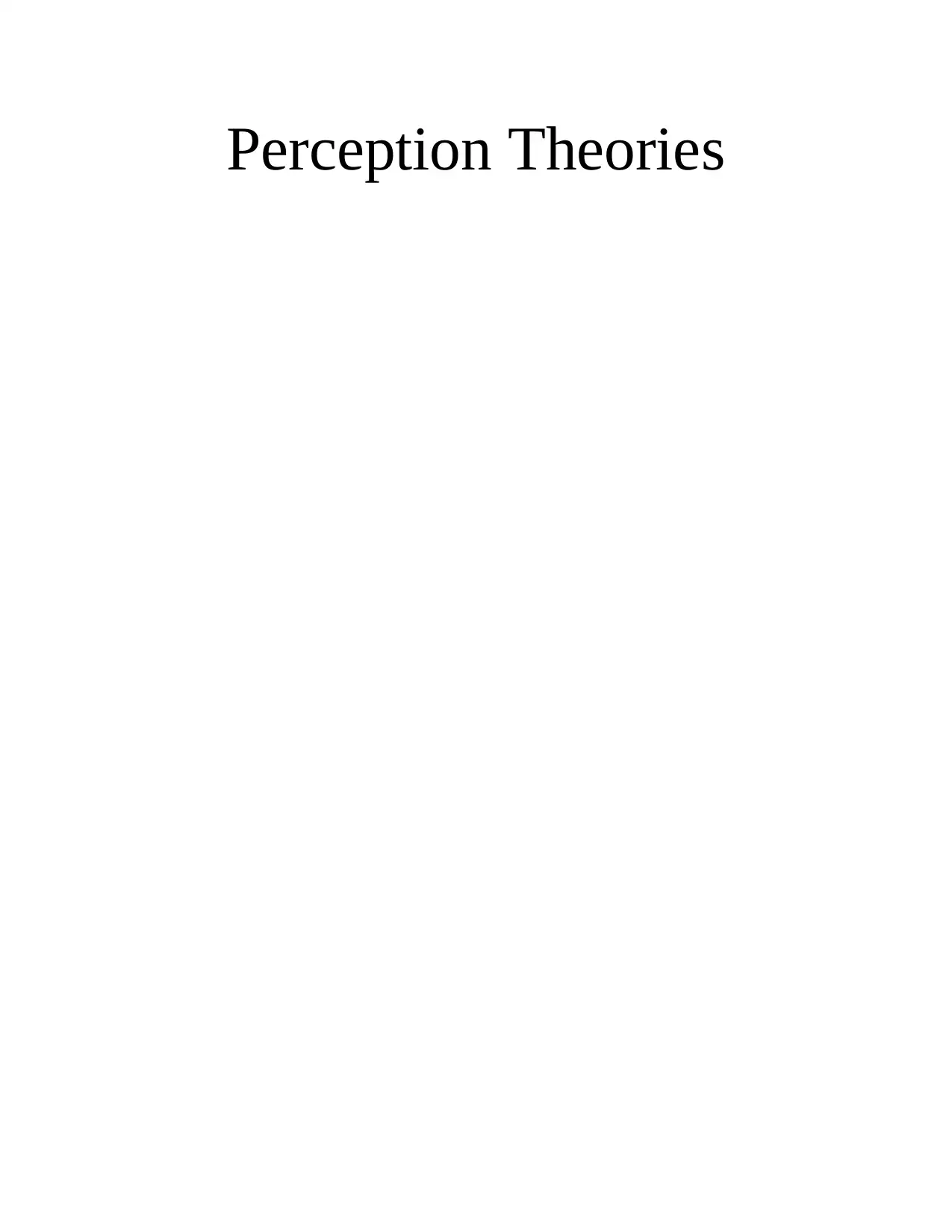
Perception Theories
Paraphrase This Document
Need a fresh take? Get an instant paraphrase of this document with our AI Paraphraser
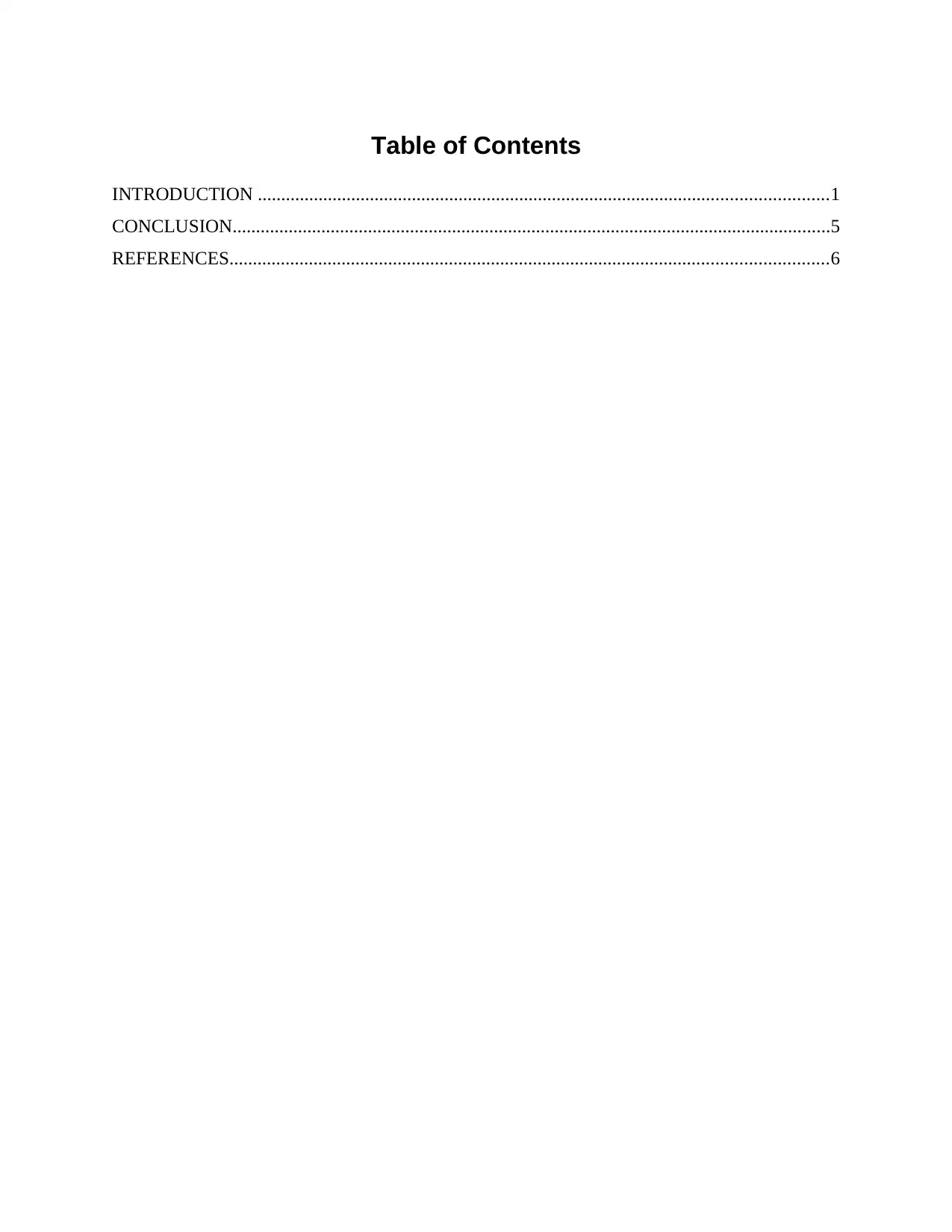
Table of Contents
INTRODUCTION ..........................................................................................................................1
CONCLUSION................................................................................................................................5
REFERENCES................................................................................................................................6
INTRODUCTION ..........................................................................................................................1
CONCLUSION................................................................................................................................5
REFERENCES................................................................................................................................6
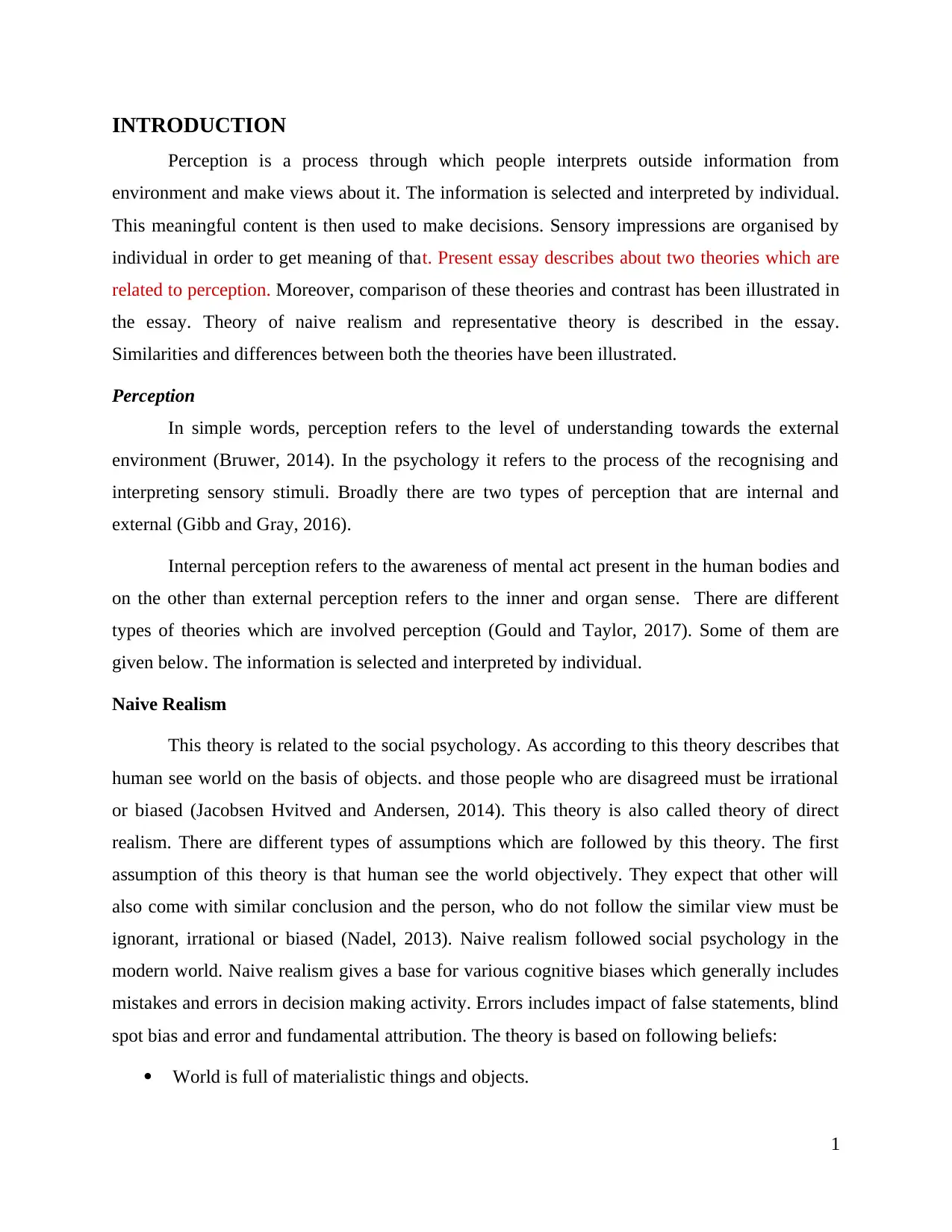
INTRODUCTION
Perception is a process through which people interprets outside information from
environment and make views about it. The information is selected and interpreted by individual.
This meaningful content is then used to make decisions. Sensory impressions are organised by
individual in order to get meaning of that. Present essay describes about two theories which are
related to perception. Moreover, comparison of these theories and contrast has been illustrated in
the essay. Theory of naive realism and representative theory is described in the essay.
Similarities and differences between both the theories have been illustrated.
Perception
In simple words, perception refers to the level of understanding towards the external
environment (Bruwer, 2014). In the psychology it refers to the process of the recognising and
interpreting sensory stimuli. Broadly there are two types of perception that are internal and
external (Gibb and Gray, 2016).
Internal perception refers to the awareness of mental act present in the human bodies and
on the other than external perception refers to the inner and organ sense. There are different
types of theories which are involved perception (Gould and Taylor, 2017). Some of them are
given below. The information is selected and interpreted by individual.
Naive Realism
This theory is related to the social psychology. As according to this theory describes that
human see world on the basis of objects. and those people who are disagreed must be irrational
or biased (Jacobsen Hvitved and Andersen, 2014). This theory is also called theory of direct
realism. There are different types of assumptions which are followed by this theory. The first
assumption of this theory is that human see the world objectively. They expect that other will
also come with similar conclusion and the person, who do not follow the similar view must be
ignorant, irrational or biased (Nadel, 2013). Naive realism followed social psychology in the
modern world. Naive realism gives a base for various cognitive biases which generally includes
mistakes and errors in decision making activity. Errors includes impact of false statements, blind
spot bias and error and fundamental attribution. The theory is based on following beliefs:
World is full of materialistic things and objects.
1
Perception is a process through which people interprets outside information from
environment and make views about it. The information is selected and interpreted by individual.
This meaningful content is then used to make decisions. Sensory impressions are organised by
individual in order to get meaning of that. Present essay describes about two theories which are
related to perception. Moreover, comparison of these theories and contrast has been illustrated in
the essay. Theory of naive realism and representative theory is described in the essay.
Similarities and differences between both the theories have been illustrated.
Perception
In simple words, perception refers to the level of understanding towards the external
environment (Bruwer, 2014). In the psychology it refers to the process of the recognising and
interpreting sensory stimuli. Broadly there are two types of perception that are internal and
external (Gibb and Gray, 2016).
Internal perception refers to the awareness of mental act present in the human bodies and
on the other than external perception refers to the inner and organ sense. There are different
types of theories which are involved perception (Gould and Taylor, 2017). Some of them are
given below. The information is selected and interpreted by individual.
Naive Realism
This theory is related to the social psychology. As according to this theory describes that
human see world on the basis of objects. and those people who are disagreed must be irrational
or biased (Jacobsen Hvitved and Andersen, 2014). This theory is also called theory of direct
realism. There are different types of assumptions which are followed by this theory. The first
assumption of this theory is that human see the world objectively. They expect that other will
also come with similar conclusion and the person, who do not follow the similar view must be
ignorant, irrational or biased (Nadel, 2013). Naive realism followed social psychology in the
modern world. Naive realism gives a base for various cognitive biases which generally includes
mistakes and errors in decision making activity. Errors includes impact of false statements, blind
spot bias and error and fundamental attribution. The theory is based on following beliefs:
World is full of materialistic things and objects.
1
⊘ This is a preview!⊘
Do you want full access?
Subscribe today to unlock all pages.

Trusted by 1+ million students worldwide
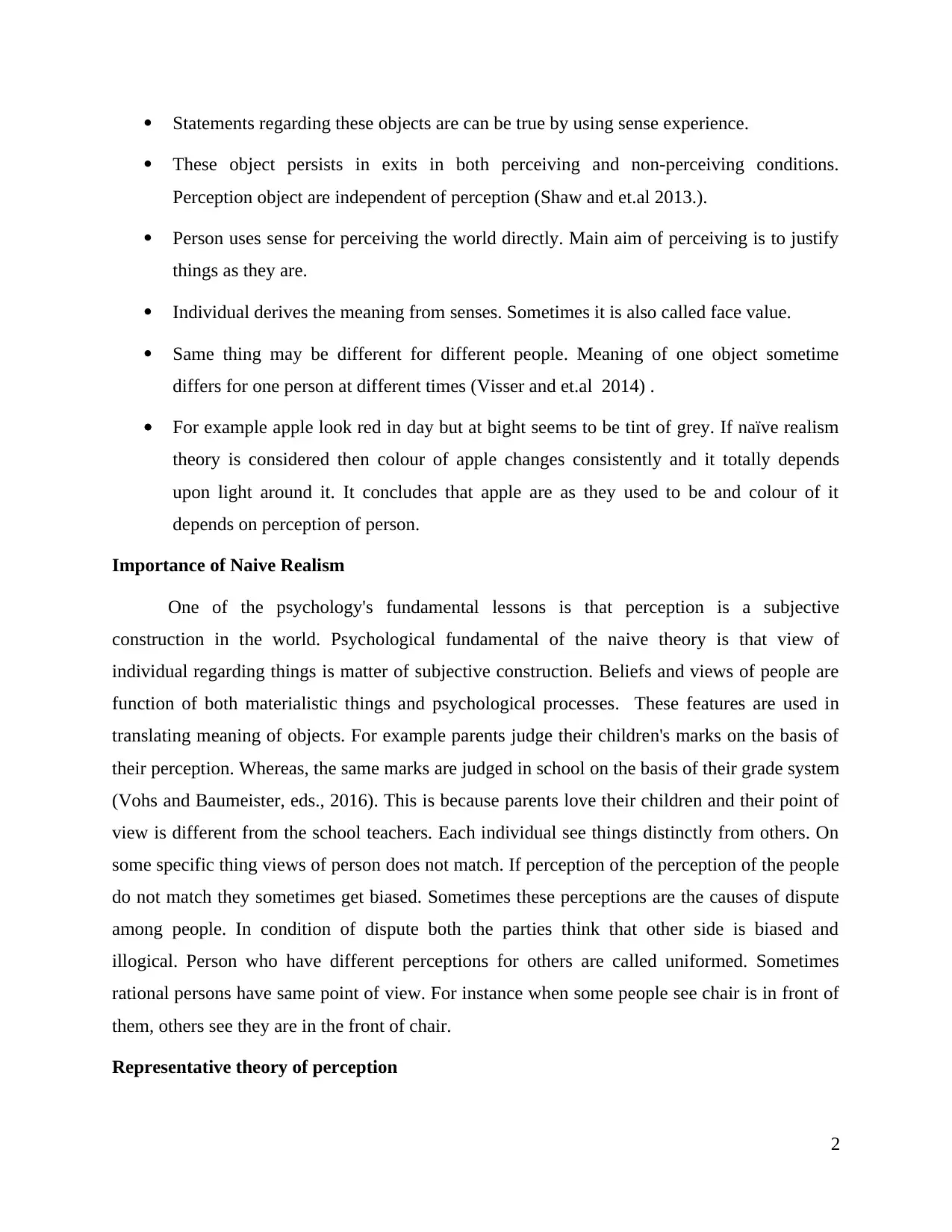
Statements regarding these objects are can be true by using sense experience.
These object persists in exits in both perceiving and non-perceiving conditions.
Perception object are independent of perception (Shaw and et.al 2013.).
Person uses sense for perceiving the world directly. Main aim of perceiving is to justify
things as they are.
Individual derives the meaning from senses. Sometimes it is also called face value.
Same thing may be different for different people. Meaning of one object sometime
differs for one person at different times (Visser and et.al 2014) .
For example apple look red in day but at bight seems to be tint of grey. If naïve realism
theory is considered then colour of apple changes consistently and it totally depends
upon light around it. It concludes that apple are as they used to be and colour of it
depends on perception of person.
Importance of Naive Realism
One of the psychology's fundamental lessons is that perception is a subjective
construction in the world. Psychological fundamental of the naive theory is that view of
individual regarding things is matter of subjective construction. Beliefs and views of people are
function of both materialistic things and psychological processes. These features are used in
translating meaning of objects. For example parents judge their children's marks on the basis of
their perception. Whereas, the same marks are judged in school on the basis of their grade system
(Vohs and Baumeister, eds., 2016). This is because parents love their children and their point of
view is different from the school teachers. Each individual see things distinctly from others. On
some specific thing views of person does not match. If perception of the perception of the people
do not match they sometimes get biased. Sometimes these perceptions are the causes of dispute
among people. In condition of dispute both the parties think that other side is biased and
illogical. Person who have different perceptions for others are called uniformed. Sometimes
rational persons have same point of view. For instance when some people see chair is in front of
them, others see they are in the front of chair.
Representative theory of perception
2
These object persists in exits in both perceiving and non-perceiving conditions.
Perception object are independent of perception (Shaw and et.al 2013.).
Person uses sense for perceiving the world directly. Main aim of perceiving is to justify
things as they are.
Individual derives the meaning from senses. Sometimes it is also called face value.
Same thing may be different for different people. Meaning of one object sometime
differs for one person at different times (Visser and et.al 2014) .
For example apple look red in day but at bight seems to be tint of grey. If naïve realism
theory is considered then colour of apple changes consistently and it totally depends
upon light around it. It concludes that apple are as they used to be and colour of it
depends on perception of person.
Importance of Naive Realism
One of the psychology's fundamental lessons is that perception is a subjective
construction in the world. Psychological fundamental of the naive theory is that view of
individual regarding things is matter of subjective construction. Beliefs and views of people are
function of both materialistic things and psychological processes. These features are used in
translating meaning of objects. For example parents judge their children's marks on the basis of
their perception. Whereas, the same marks are judged in school on the basis of their grade system
(Vohs and Baumeister, eds., 2016). This is because parents love their children and their point of
view is different from the school teachers. Each individual see things distinctly from others. On
some specific thing views of person does not match. If perception of the perception of the people
do not match they sometimes get biased. Sometimes these perceptions are the causes of dispute
among people. In condition of dispute both the parties think that other side is biased and
illogical. Person who have different perceptions for others are called uniformed. Sometimes
rational persons have same point of view. For instance when some people see chair is in front of
them, others see they are in the front of chair.
Representative theory of perception
2
Paraphrase This Document
Need a fresh take? Get an instant paraphrase of this document with our AI Paraphraser
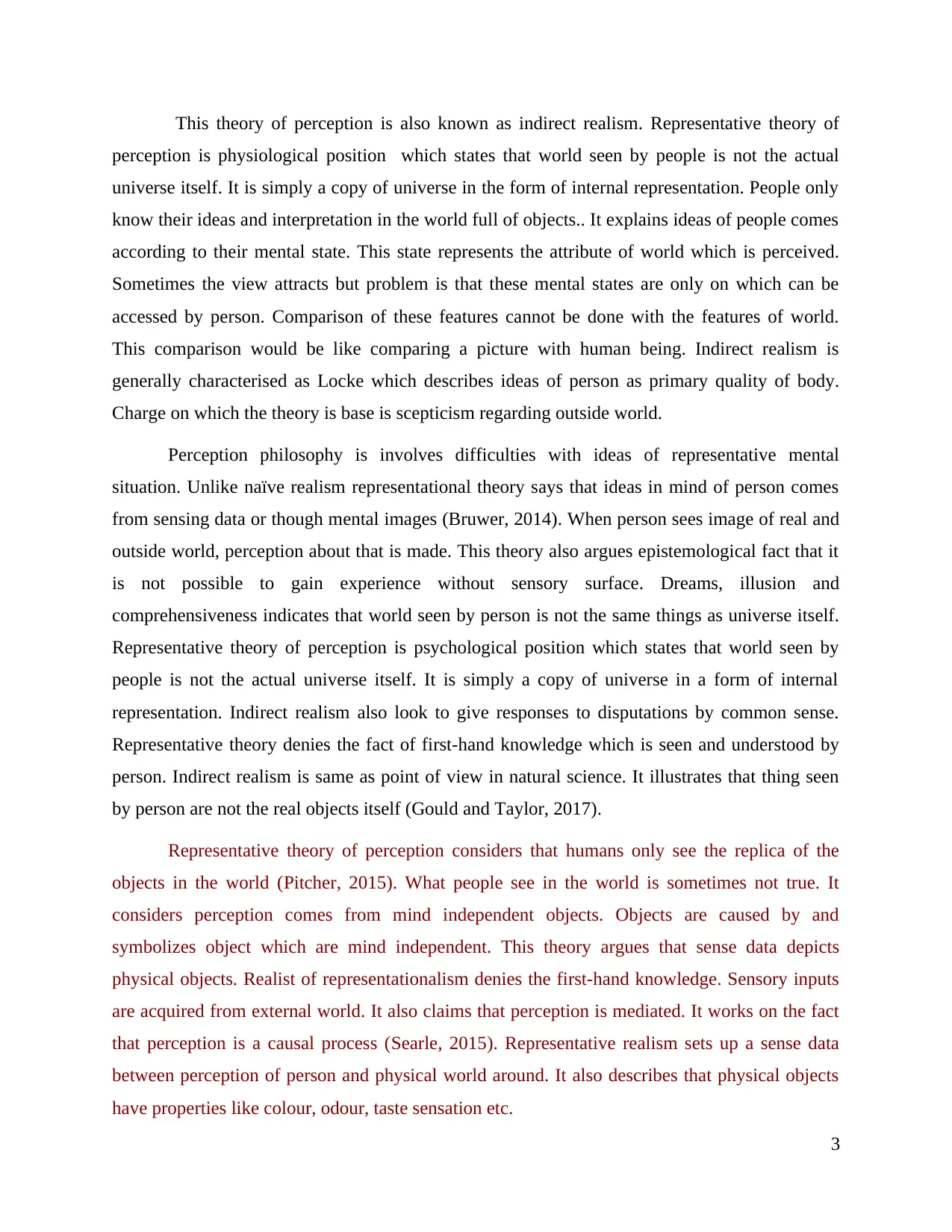
This theory of perception is also known as indirect realism. Representative theory of
perception is physiological position which states that world seen by people is not the actual
universe itself. It is simply a copy of universe in the form of internal representation. People only
know their ideas and interpretation in the world full of objects.. It explains ideas of people comes
according to their mental state. This state represents the attribute of world which is perceived.
Sometimes the view attracts but problem is that these mental states are only on which can be
accessed by person. Comparison of these features cannot be done with the features of world.
This comparison would be like comparing a picture with human being. Indirect realism is
generally characterised as Locke which describes ideas of person as primary quality of body.
Charge on which the theory is base is scepticism regarding outside world.
Perception philosophy is involves difficulties with ideas of representative mental
situation. Unlike naïve realism representational theory says that ideas in mind of person comes
from sensing data or though mental images (Bruwer, 2014). When person sees image of real and
outside world, perception about that is made. This theory also argues epistemological fact that it
is not possible to gain experience without sensory surface. Dreams, illusion and
comprehensiveness indicates that world seen by person is not the same things as universe itself.
Representative theory of perception is psychological position which states that world seen by
people is not the actual universe itself. It is simply a copy of universe in a form of internal
representation. Indirect realism also look to give responses to disputations by common sense.
Representative theory denies the fact of first-hand knowledge which is seen and understood by
person. Indirect realism is same as point of view in natural science. It illustrates that thing seen
by person are not the real objects itself (Gould and Taylor, 2017).
Representative theory of perception considers that humans only see the replica of the
objects in the world (Pitcher, 2015). What people see in the world is sometimes not true. It
considers perception comes from mind independent objects. Objects are caused by and
symbolizes object which are mind independent. This theory argues that sense data depicts
physical objects. Realist of representationalism denies the first-hand knowledge. Sensory inputs
are acquired from external world. It also claims that perception is mediated. It works on the fact
that perception is a causal process (Searle, 2015). Representative realism sets up a sense data
between perception of person and physical world around. It also describes that physical objects
have properties like colour, odour, taste sensation etc.
3
perception is physiological position which states that world seen by people is not the actual
universe itself. It is simply a copy of universe in the form of internal representation. People only
know their ideas and interpretation in the world full of objects.. It explains ideas of people comes
according to their mental state. This state represents the attribute of world which is perceived.
Sometimes the view attracts but problem is that these mental states are only on which can be
accessed by person. Comparison of these features cannot be done with the features of world.
This comparison would be like comparing a picture with human being. Indirect realism is
generally characterised as Locke which describes ideas of person as primary quality of body.
Charge on which the theory is base is scepticism regarding outside world.
Perception philosophy is involves difficulties with ideas of representative mental
situation. Unlike naïve realism representational theory says that ideas in mind of person comes
from sensing data or though mental images (Bruwer, 2014). When person sees image of real and
outside world, perception about that is made. This theory also argues epistemological fact that it
is not possible to gain experience without sensory surface. Dreams, illusion and
comprehensiveness indicates that world seen by person is not the same things as universe itself.
Representative theory of perception is psychological position which states that world seen by
people is not the actual universe itself. It is simply a copy of universe in a form of internal
representation. Indirect realism also look to give responses to disputations by common sense.
Representative theory denies the fact of first-hand knowledge which is seen and understood by
person. Indirect realism is same as point of view in natural science. It illustrates that thing seen
by person are not the real objects itself (Gould and Taylor, 2017).
Representative theory of perception considers that humans only see the replica of the
objects in the world (Pitcher, 2015). What people see in the world is sometimes not true. It
considers perception comes from mind independent objects. Objects are caused by and
symbolizes object which are mind independent. This theory argues that sense data depicts
physical objects. Realist of representationalism denies the first-hand knowledge. Sensory inputs
are acquired from external world. It also claims that perception is mediated. It works on the fact
that perception is a causal process (Searle, 2015). Representative realism sets up a sense data
between perception of person and physical world around. It also describes that physical objects
have properties like colour, odour, taste sensation etc.
3
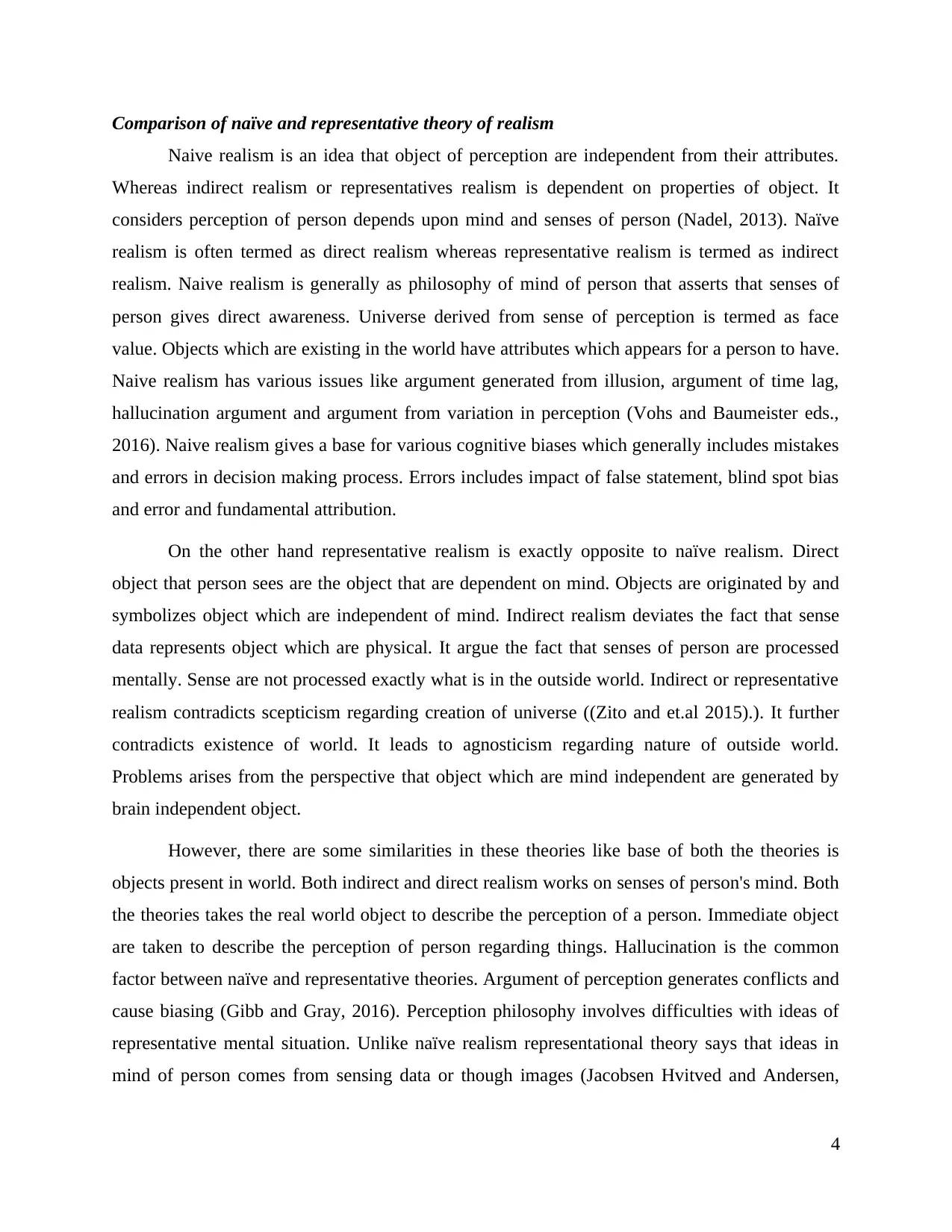
Comparison of naïve and representative theory of realism
Naive realism is an idea that object of perception are independent from their attributes.
Whereas indirect realism or representatives realism is dependent on properties of object. It
considers perception of person depends upon mind and senses of person (Nadel, 2013). Naïve
realism is often termed as direct realism whereas representative realism is termed as indirect
realism. Naive realism is generally as philosophy of mind of person that asserts that senses of
person gives direct awareness. Universe derived from sense of perception is termed as face
value. Objects which are existing in the world have attributes which appears for a person to have.
Naive realism has various issues like argument generated from illusion, argument of time lag,
hallucination argument and argument from variation in perception (Vohs and Baumeister eds.,
2016). Naive realism gives a base for various cognitive biases which generally includes mistakes
and errors in decision making process. Errors includes impact of false statement, blind spot bias
and error and fundamental attribution.
On the other hand representative realism is exactly opposite to naïve realism. Direct
object that person sees are the object that are dependent on mind. Objects are originated by and
symbolizes object which are independent of mind. Indirect realism deviates the fact that sense
data represents object which are physical. It argue the fact that senses of person are processed
mentally. Sense are not processed exactly what is in the outside world. Indirect or representative
realism contradicts scepticism regarding creation of universe ((Zito and et.al 2015).). It further
contradicts existence of world. It leads to agnosticism regarding nature of outside world.
Problems arises from the perspective that object which are mind independent are generated by
brain independent object.
However, there are some similarities in these theories like base of both the theories is
objects present in world. Both indirect and direct realism works on senses of person's mind. Both
the theories takes the real world object to describe the perception of a person. Immediate object
are taken to describe the perception of person regarding things. Hallucination is the common
factor between naïve and representative theories. Argument of perception generates conflicts and
cause biasing (Gibb and Gray, 2016). Perception philosophy involves difficulties with ideas of
representative mental situation. Unlike naïve realism representational theory says that ideas in
mind of person comes from sensing data or though images (Jacobsen Hvitved and Andersen,
4
Naive realism is an idea that object of perception are independent from their attributes.
Whereas indirect realism or representatives realism is dependent on properties of object. It
considers perception of person depends upon mind and senses of person (Nadel, 2013). Naïve
realism is often termed as direct realism whereas representative realism is termed as indirect
realism. Naive realism is generally as philosophy of mind of person that asserts that senses of
person gives direct awareness. Universe derived from sense of perception is termed as face
value. Objects which are existing in the world have attributes which appears for a person to have.
Naive realism has various issues like argument generated from illusion, argument of time lag,
hallucination argument and argument from variation in perception (Vohs and Baumeister eds.,
2016). Naive realism gives a base for various cognitive biases which generally includes mistakes
and errors in decision making process. Errors includes impact of false statement, blind spot bias
and error and fundamental attribution.
On the other hand representative realism is exactly opposite to naïve realism. Direct
object that person sees are the object that are dependent on mind. Objects are originated by and
symbolizes object which are independent of mind. Indirect realism deviates the fact that sense
data represents object which are physical. It argue the fact that senses of person are processed
mentally. Sense are not processed exactly what is in the outside world. Indirect or representative
realism contradicts scepticism regarding creation of universe ((Zito and et.al 2015).). It further
contradicts existence of world. It leads to agnosticism regarding nature of outside world.
Problems arises from the perspective that object which are mind independent are generated by
brain independent object.
However, there are some similarities in these theories like base of both the theories is
objects present in world. Both indirect and direct realism works on senses of person's mind. Both
the theories takes the real world object to describe the perception of a person. Immediate object
are taken to describe the perception of person regarding things. Hallucination is the common
factor between naïve and representative theories. Argument of perception generates conflicts and
cause biasing (Gibb and Gray, 2016). Perception philosophy involves difficulties with ideas of
representative mental situation. Unlike naïve realism representational theory says that ideas in
mind of person comes from sensing data or though images (Jacobsen Hvitved and Andersen,
4
⊘ This is a preview!⊘
Do you want full access?
Subscribe today to unlock all pages.

Trusted by 1+ million students worldwide
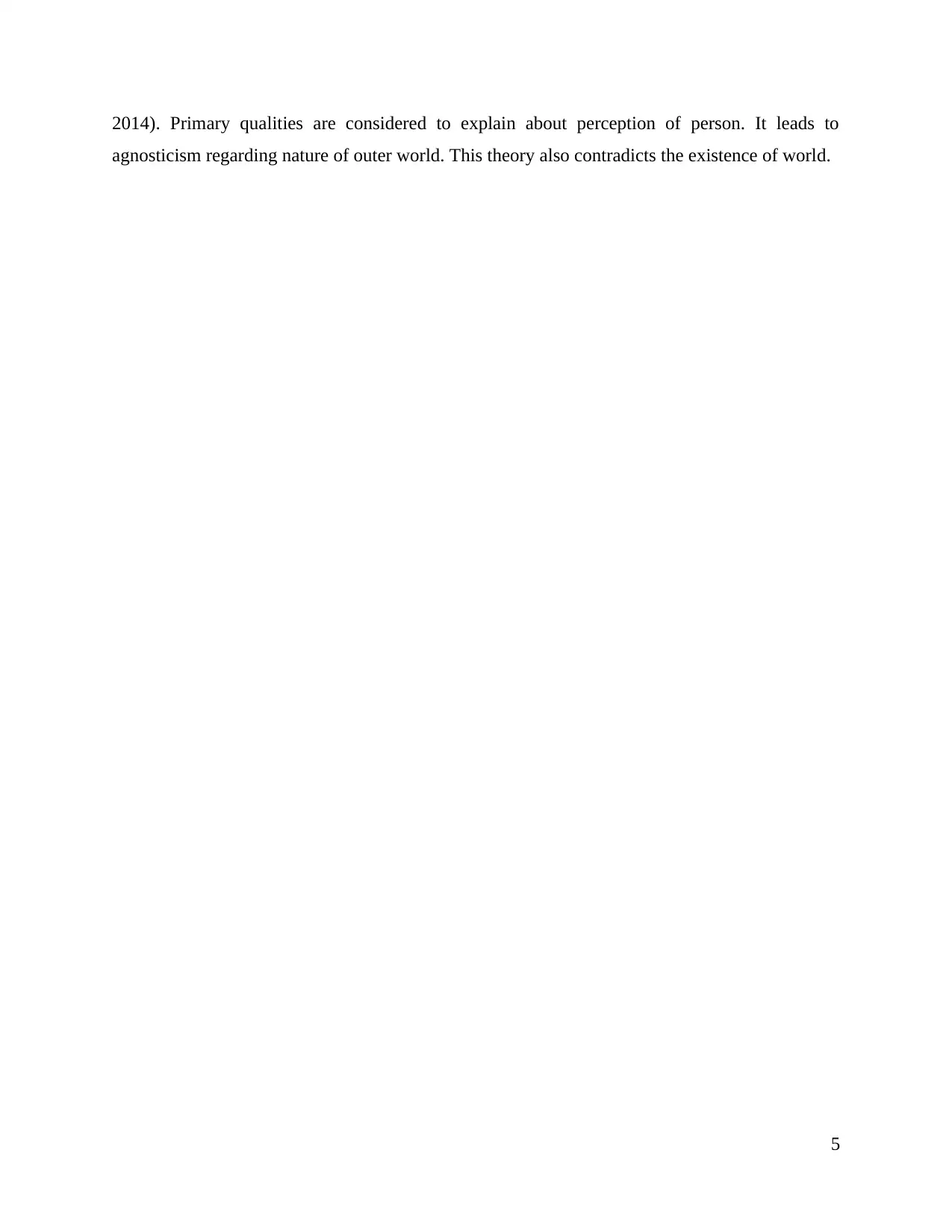
2014). Primary qualities are considered to explain about perception of person. It leads to
agnosticism regarding nature of outer world. This theory also contradicts the existence of world.
5
agnosticism regarding nature of outer world. This theory also contradicts the existence of world.
5
Paraphrase This Document
Need a fresh take? Get an instant paraphrase of this document with our AI Paraphraser
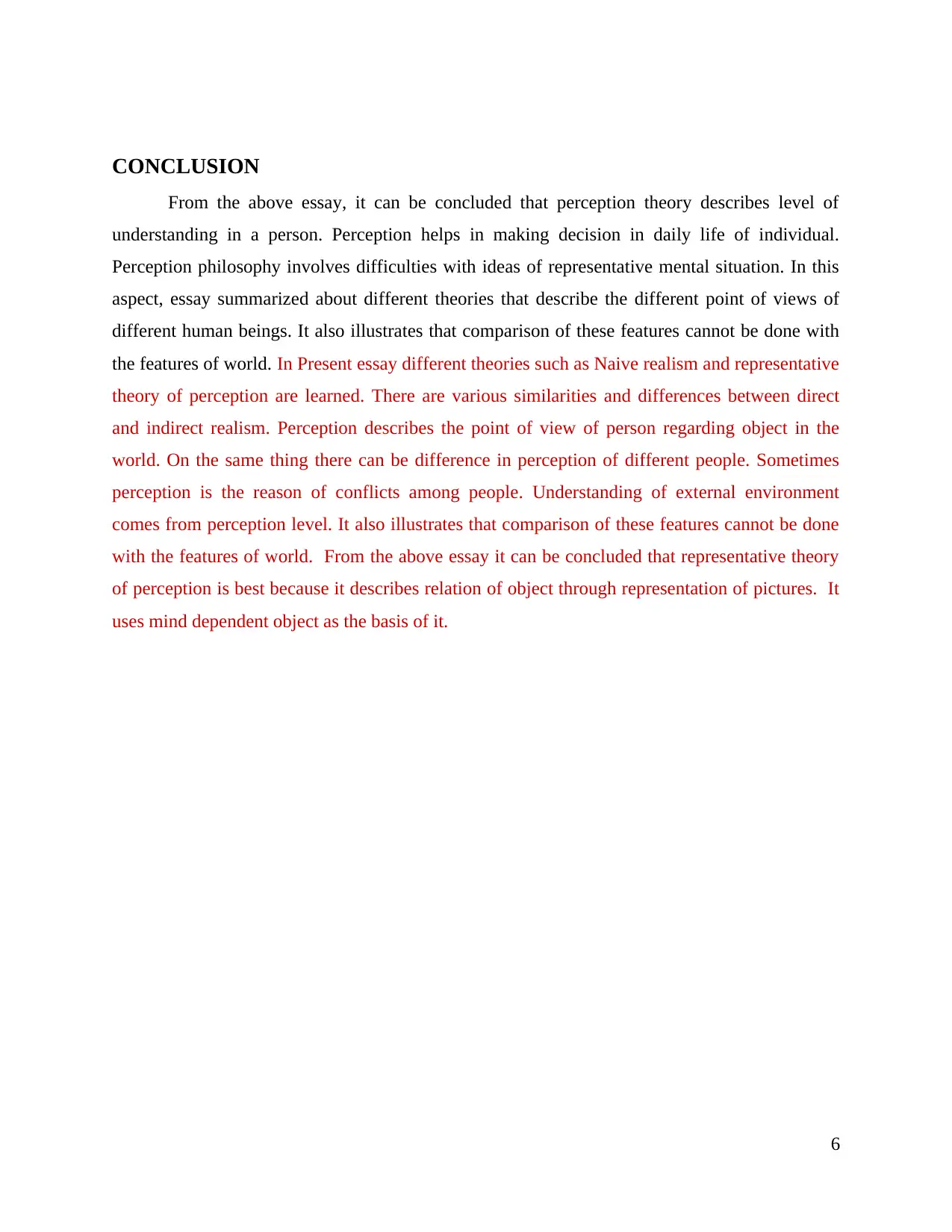
CONCLUSION
From the above essay, it can be concluded that perception theory describes level of
understanding in a person. Perception helps in making decision in daily life of individual.
Perception philosophy involves difficulties with ideas of representative mental situation. In this
aspect, essay summarized about different theories that describe the different point of views of
different human beings. It also illustrates that comparison of these features cannot be done with
the features of world. In Present essay different theories such as Naive realism and representative
theory of perception are learned. There are various similarities and differences between direct
and indirect realism. Perception describes the point of view of person regarding object in the
world. On the same thing there can be difference in perception of different people. Sometimes
perception is the reason of conflicts among people. Understanding of external environment
comes from perception level. It also illustrates that comparison of these features cannot be done
with the features of world. From the above essay it can be concluded that representative theory
of perception is best because it describes relation of object through representation of pictures. It
uses mind dependent object as the basis of it.
6
From the above essay, it can be concluded that perception theory describes level of
understanding in a person. Perception helps in making decision in daily life of individual.
Perception philosophy involves difficulties with ideas of representative mental situation. In this
aspect, essay summarized about different theories that describe the different point of views of
different human beings. It also illustrates that comparison of these features cannot be done with
the features of world. In Present essay different theories such as Naive realism and representative
theory of perception are learned. There are various similarities and differences between direct
and indirect realism. Perception describes the point of view of person regarding object in the
world. On the same thing there can be difference in perception of different people. Sometimes
perception is the reason of conflicts among people. Understanding of external environment
comes from perception level. It also illustrates that comparison of these features cannot be done
with the features of world. From the above essay it can be concluded that representative theory
of perception is best because it describes relation of object through representation of pictures. It
uses mind dependent object as the basis of it.
6
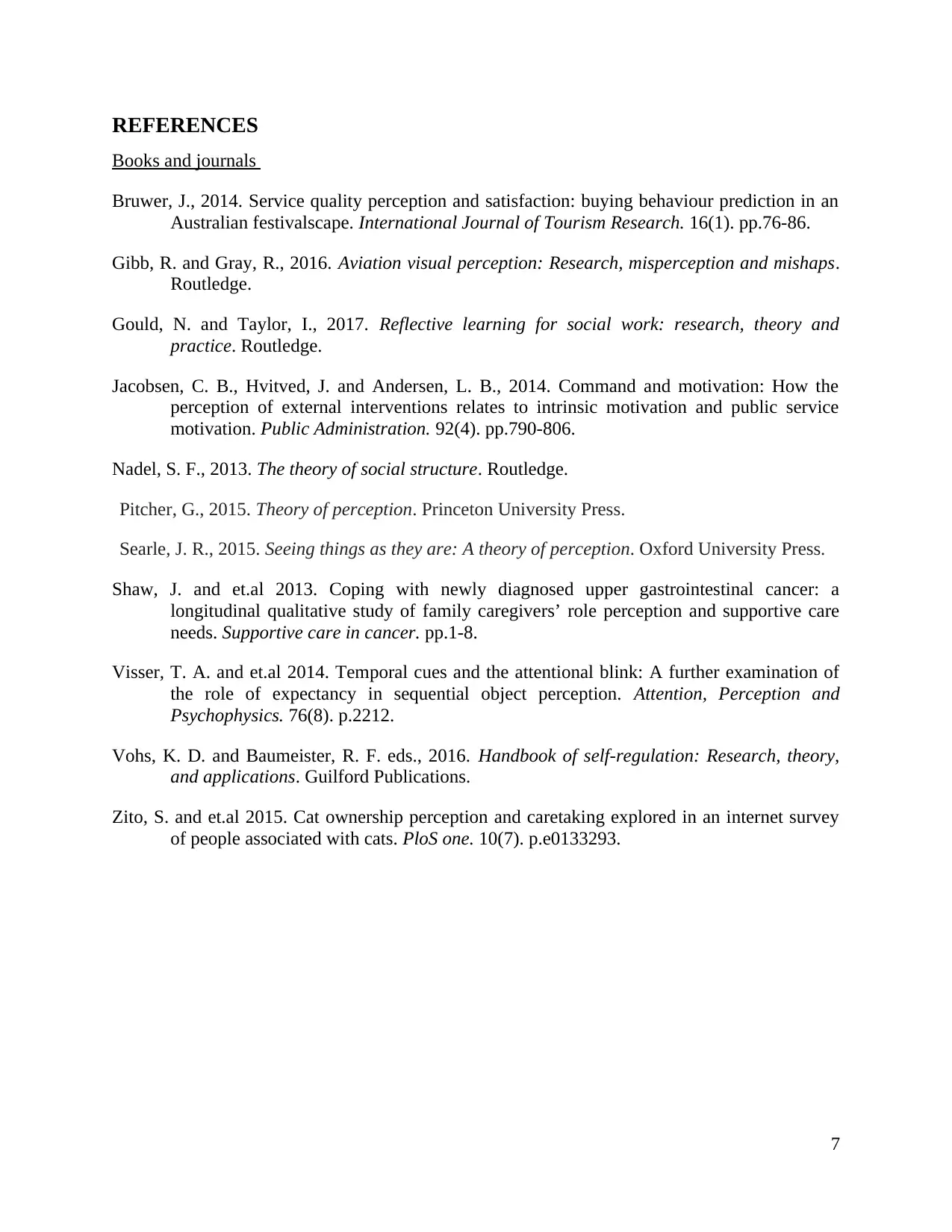
REFERENCES
Books and journals
Bruwer, J., 2014. Service quality perception and satisfaction: buying behaviour prediction in an
Australian festivalscape. International Journal of Tourism Research. 16(1). pp.76-86.
Gibb, R. and Gray, R., 2016. Aviation visual perception: Research, misperception and mishaps.
Routledge.
Gould, N. and Taylor, I., 2017. Reflective learning for social work: research, theory and
practice. Routledge.
Jacobsen, C. B., Hvitved, J. and Andersen, L. B., 2014. Command and motivation: How the
perception of external interventions relates to intrinsic motivation and public service
motivation. Public Administration. 92(4). pp.790-806.
Nadel, S. F., 2013. The theory of social structure. Routledge.
Pitcher, G., 2015. Theory of perception. Princeton University Press.
Searle, J. R., 2015. Seeing things as they are: A theory of perception. Oxford University Press.
Shaw, J. and et.al 2013. Coping with newly diagnosed upper gastrointestinal cancer: a
longitudinal qualitative study of family caregivers’ role perception and supportive care
needs. Supportive care in cancer. pp.1-8.
Visser, T. A. and et.al 2014. Temporal cues and the attentional blink: A further examination of
the role of expectancy in sequential object perception. Attention, Perception and
Psychophysics. 76(8). p.2212.
Vohs, K. D. and Baumeister, R. F. eds., 2016. Handbook of self-regulation: Research, theory,
and applications. Guilford Publications.
Zito, S. and et.al 2015. Cat ownership perception and caretaking explored in an internet survey
of people associated with cats. PloS one. 10(7). p.e0133293.
7
Books and journals
Bruwer, J., 2014. Service quality perception and satisfaction: buying behaviour prediction in an
Australian festivalscape. International Journal of Tourism Research. 16(1). pp.76-86.
Gibb, R. and Gray, R., 2016. Aviation visual perception: Research, misperception and mishaps.
Routledge.
Gould, N. and Taylor, I., 2017. Reflective learning for social work: research, theory and
practice. Routledge.
Jacobsen, C. B., Hvitved, J. and Andersen, L. B., 2014. Command and motivation: How the
perception of external interventions relates to intrinsic motivation and public service
motivation. Public Administration. 92(4). pp.790-806.
Nadel, S. F., 2013. The theory of social structure. Routledge.
Pitcher, G., 2015. Theory of perception. Princeton University Press.
Searle, J. R., 2015. Seeing things as they are: A theory of perception. Oxford University Press.
Shaw, J. and et.al 2013. Coping with newly diagnosed upper gastrointestinal cancer: a
longitudinal qualitative study of family caregivers’ role perception and supportive care
needs. Supportive care in cancer. pp.1-8.
Visser, T. A. and et.al 2014. Temporal cues and the attentional blink: A further examination of
the role of expectancy in sequential object perception. Attention, Perception and
Psychophysics. 76(8). p.2212.
Vohs, K. D. and Baumeister, R. F. eds., 2016. Handbook of self-regulation: Research, theory,
and applications. Guilford Publications.
Zito, S. and et.al 2015. Cat ownership perception and caretaking explored in an internet survey
of people associated with cats. PloS one. 10(7). p.e0133293.
7
⊘ This is a preview!⊘
Do you want full access?
Subscribe today to unlock all pages.

Trusted by 1+ million students worldwide
1 out of 9
Related Documents
Your All-in-One AI-Powered Toolkit for Academic Success.
+13062052269
info@desklib.com
Available 24*7 on WhatsApp / Email
![[object Object]](/_next/static/media/star-bottom.7253800d.svg)
Unlock your academic potential
Copyright © 2020–2025 A2Z Services. All Rights Reserved. Developed and managed by ZUCOL.





